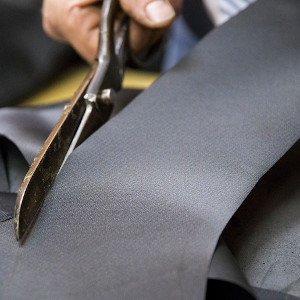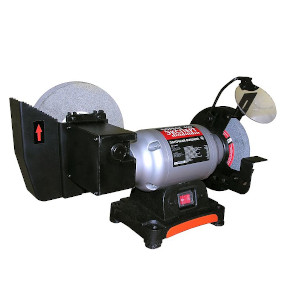Scissors and shears are known as a similar term. But they are quite different from each other. Although they serve the same primary purpose of cutting or slicing thin materials. But from the arena of sewing, both of them have distinctive features in terms of structure, mechanism functions, etc.
Shears Vs Scissors: Overview
 Structural Description
Structural Description
A simple pair of fabric scissors consists of two metal blades that have sharp edges. These blades are dependent on each other, and a lever connects them. The edges are sharp and smooth but straight. A pair of good quality scissors follow engineering principles. The handles compose plastic polymer materials and sometimes rubber too. Upon heating or under high temperature, they soften up but solidify again on cooling down.
Shears in terms of sewing are also known as pinking shears. They are quite similar to regular scissors but have a distinctive feature which makes it unique. The pivot blades of shears have saw-toothed protrusions. Instead of straight edge, pinking shears have zigzag sides due to the presence of teeth-like structures on it. Each blade has three layers along the border with a metallic layer in between, hence the name ‘pink’ in pinking.
History
Scissors are known to appear around 3000 years ago. They had bronze blades. The handles were of bendable strips of bronze which also help in aligning. The use of a curved piece was to squeeze both the edge together. On release, they came apart. Later these scissors were then made of steel. The ends at high temperatures gave them the shape of blades. Modern-day scissors were the invention of Robert Hinchliffe in the year 1761, which was of cast steel. Gradually, the handles had elaborate designing along with holes in between them for a better grip.
But, sewing shears are not a very old invention. Louise Austin was the designer of the pinking shear and had a patent on his name in 1893.
Operation
The regular pair scissor operates when both handles come together, and the sharp edges of the blades move through a thin material or fabric. The action in between the two blades creates tension that slices the cloth when sliding past through it. The two parts of the textile produce a clean and smooth edge when cutting with a sharp scissor.
Likewise, the mechanism of a pinking shear is also the same, i.e.; the fabric is cut into two parts while sliding through it. However, each cut part has zigzag edges due to the sawtooth structures on the blades.
 Functional Uses
Functional Uses
Scissors are used in sewing to cut fabric or thread. A good quality tailor’s scissor with extra sharp blades is useful while cutting delicate materials like silk, chiffon, lace, sheer fabrics, etc.
Shears, on the other hand, is used in sewing by experienced and skilled workers. These are helpful while cutting woven cloth and any different fabric that has frayed edges. The pinking shears are preferable for tailors because they minimize the length of threads hanging of faulty materials. However, they do not prevent fraying. The cut fabric has zigzag edges and is useful for artists and creative people for their decorative and pattern cuts in fabric material. They reduce damage in cloths that has no hem.
Sizes
Ordinary sewing scissors have blades not longer than 6 inches. But shears have long blade typically between 7-10 inches
The handles of scissors are smaller, and those of shears are more extended and broader for a much better grip.
Shears Vs Scissors: Sharpening Methods
 Both scissors have blades in them, which tend to become coarse and dull in due course of time. With continuous use, the blades become blunt and sometimes also become rusty because of steel and iron in it. However, instead of purchasing new pairs every time a scissor gets dull, sharpening them is a better idea. But the process of sharpening a scissor is different from that of a shear.
Both scissors have blades in them, which tend to become coarse and dull in due course of time. With continuous use, the blades become blunt and sometimes also become rusty because of steel and iron in it. However, instead of purchasing new pairs every time a scissor gets dull, sharpening them is a better idea. But the process of sharpening a scissor is different from that of a shear.
To sharpen scissors, you may use the rough side of a bench stone, sandpaper or emery cloth. The process is quite simple. Just rub the blade on the grit particles, and the friction will give instant sharpness. For better results, continue the process for a longer time and check the sharpness on a piece of scrap fabric.
In the case of pinking shears, one may use aluminum foil. Just fold the foil multiple times and cut through it for several minutes.
Using sandpaper is another option that is readily available in every household and cheap as well.
However, for sharpness like a new one, use the sharpening wheel. Remember to take the blades apart from each other and sharpen one blade at a time. Just the edges of the teeth need sharpening and not the area in between every tooth. Before turning on the machine, try a scratch test first to know if you are doing the right way. The visibility of the layers on the edges will indicate if sharpening is complete.
Shears Vs Scissors: Final Thoughts
The differences of shears vs scissors do not imply that they are poles apart. They serve a similar function of cutting materials. But, in sewing, pinking shears have more preference than the regular scissors as they minimize length fraying until the edges are hem.
The ultimate look of the sewing project will hamper if its borders are not proper and clean. However, it’s the choice of each dressmaker or sewist with which they are comfortable. Without adequate grip or hold on the scissor or shear will not serve the primary function of achieving an aligned or smooth cut.
Whichever you use, maintaining the sharpness is a must. A dull and blunt blade of scissor or pinking shear is absolute of no use to a tailor. One can use cost-effective and readily available materials as household remedies or get professional help if they do not work. For better results in your sewing project, keep the materials well-maintained and clean so that you do not have to stop working mid-way. Let yourself experience the joy of sewing and excel in the craft.


